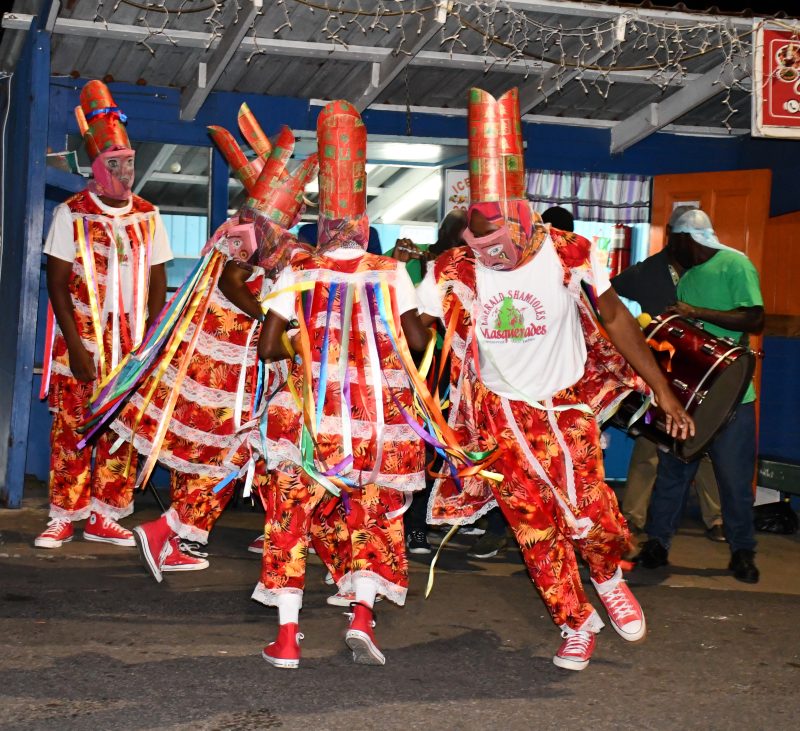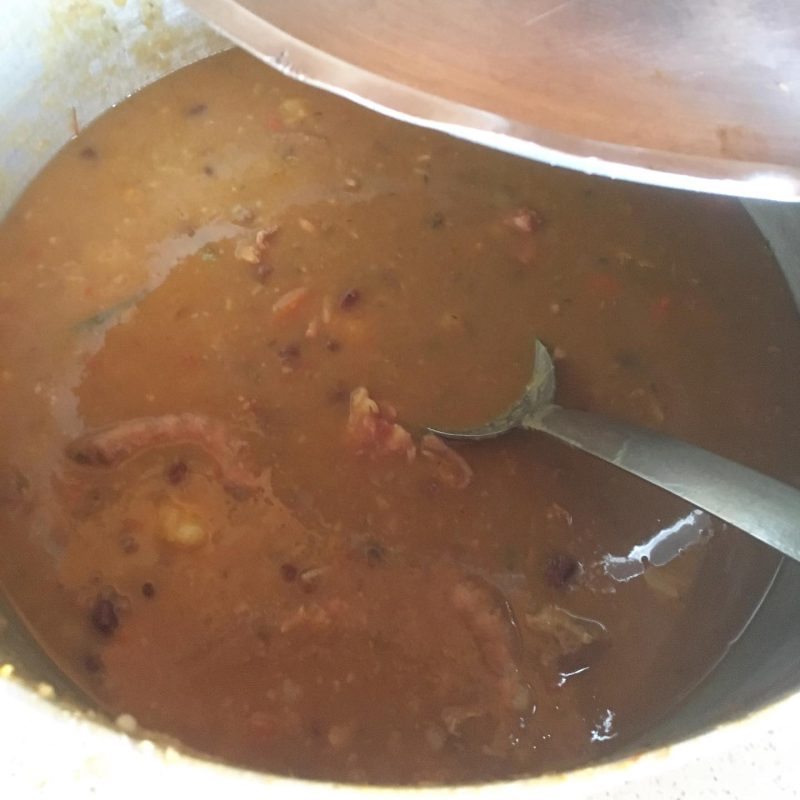In the heart of the Caribbean, where lush rainforests and pristine waters meet, a remarkable story of conservation and collaboration unfolds. The Critically Endangered Mountain Chicken Frog (Leptodactylus fallax) has been teetering on the brink of extinction for years, but a recent emergency population survey, conducted with the support of national, regional, and international partners, brings a glimmer of hope for these charismatic amphibians.
The Challenge
The Mountain Chicken Frog, affectionately known as the “Kwapo” or “Crapaud” in Dominica’s Kwéyòl language in part because of its large size, is native to the islands of Dominica and Montserrat. With its unique features, including an intriguing call that is sometimes mistaken for a faint dog bark, this frog is an icon of biodiversity in the Caribbean. Once abundant throughout these paradisiacal landscapes, it has suffered a catastrophic decline, primarily due to the deadly chytrid fungus and habitat loss, along with an array of other threats that are pushing it to the brink of extinction.
The chytrid fungal disease has spread its spore-laden grip across the Caribbean and the Americas, infiltrating habitats and wreaking havoc on frog populations since the 1990s. For the Mountain Chicken Frog who came face to face with the fungus in 2002, the impact has been nothing short of catastrophic. In just one year following the introduction of the chytrid fungus, their population plummeted by a staggering 80%, making it one of the fastest amphibian declines ever recorded.
Jeanelle Brisbane, Assistant Forest Officer of the Forestry Division in Dominica and Founder of WildDominique, reflected on how the soundscape of the forests on her home island has changed since. “Imagine a bustling forest teeming with life, where the chorus of these frogs once resonated through the night. Now, picture that same forest almost eerily silent, with only a faint whisper of what was once there. This is the shocking reality of the Mountain Chicken Frog’s rapid decline.”
However, hope emerged from the darkness, as a recent study revealed signs of resilience to chytrid in some individuals surviving in the wild in Dominica, the key to the frog’s return across the islands.
The Emergency Population Survey
Recognizing the urgency of the situation, a coalition of partner NGOs, including a local wildlife organization, national governments, regional conservation bodies, and international agencies across 11 countries, embarked on an ambitious journey to survey and understand the current state of the Mountain Chicken Frog population. Their dedication and commitment were extraordinary, as the
challenges included rugged terrain, dense vegetation, and an unusually low level of rain.
The survey, spanning over 950 field hours and covering extensive areas of the last known habitat, allowed for the collection of invaluable data that is being used to assess the frog’s population size, health, and distribution. Yet, despite the long nights searching feverously in the field, the team only managed to find 23 individual frogs, with two found dead on the road – a stark reminder of just how perilous the situation has become.
Kaysie Ryan, coordinator of the Mountain Chicken Recovery Programme based in Montserrat, said, “The work conducted in Dominica was a great effort from all parties involved but a huge eye opener. There is now a new sense of urgency to get this species protected in Dominica as the conditions within the hotspots have worsened. The future of this species depends on immediate conservation action so that the future of the Mountain Chicken and bringing them back to our forests is possible on both Dominica and Montserrat.”
Hope Springs from Crisis
The Critically Endangered Mountain Chicken Frog stands at a crossroads, and its fate remains uncertain. Nevertheless, the emergency population survey has illuminated a path forward. With the collective dedication of national, regional, and international partners, there is a glimmer of hope for this charming Caribbean amphibian.
The survey managed to uncover signs of ongoing breeding with the finding of froglets and juveniles, the first since Hurricane Maria struck Dominica in 2017. The team also found what is believed to be the oldest living wild Mountain Chicken Frog, a large male whose call still echoes across the valley.
His survival in the wild, despite the chytrid fungus, tropical storms, landslides, flooding, invasive species, mining, and human encroachment, is proof of the resilience of this species. However, the battle is far from over, and the Mountain Chicken Frogs need our support more than ever.
Andrés Valenzuela Sánchez, Research Fellow in Wildlife Health at ZSL’s Institute of Zoology stated, “We’re working to understand how to recover mountain chicken frog populations, but our work shows that the chytrid fungus is not the only threat we must tackle to avoid these frogs being wiped out forever, and we need urgent support to save the species.”
This story is not just about a frog; it’s a testament to the power of collaboration and the indomitable spirit of those who believe in the conservation of our planet’s incredible biodiversity. The plight of the Mountain Chicken Frog is a reminder that, with determination and collective effort, we can turn the tide and preserve the natural wonders that make our world so beautiful and diverse.
Grateful for the number of organisations who have banded together to protect this culturally significant species, Jeanelle stated, “As we work together to protect the Critically Endangered Mountain Chicken Frog, we also reaffirm our commitment to safeguarding the ecological treasures that grace the Caribbean and the entire world. This is a cause worth fighting for, and it’s a fight we intend to win.”
About the Mountain Chicken Recovery Programme Partners
The Mountain Chicken Recovery Programme is made possible through the partnership of ZSL, Chester Zoo, Durrell Wildlife Conservation Trust, WildDominique, Nordens Ark, Riga Zoo, Fauna & Flora, The Government of Montserrat’s Department of Environment and The Forestry, Wildlife and Parks Division of the Government of the Commonwealth of Dominica. The recent survey would not have been possible without vital funding from Re:wild.
—
WildDominique
WildDominique is a Dominican non-profit organisation founded in 2018 by local ecologists, agriculturalists, marine biologist, and environmental enthusiasts seeking to preserve the island’s natural resources through local, regional, and international collaboration. At their core, WildDominique seeks to support and promote scientifically and traditionally sound conservation practices in Dominica through environmental education, community engagement, research, species preservation, and policy development, understanding that the long-term success of conservation is dependent on the input of the people. Learn more at www.wilddominique.org.
Forestry, Wildlife & Parks Division – Dominica
Established in 1949, the Forestry, Wildlife and Parks Division is an arm of the Government of Dominica tasked with the conservation, protection, management, and sustainable use of the island’s terrestrial resources. The Division aims to achieve its goal through close collaboration, partnership, and participative approach while promoting traditional knowledge access and benefit sharing for sustainable livelihoods. Visit www.forestry.gov.dm to learn more.
Montserrat National Trust
Founded in 1970, the main aims of the Montserrat National Trust are: to conserve and enhance the beauty of Montserrat; to preserve and rehabilitate historical sites, including but not limited to buildings, monuments, documents, and chattels; to preserve the fauna and flora of Montserrat; to make the public aware of the value and beauty of the island’s heritage; to pursue a policy of preservation and act in an advisory capacity; to acquire property for the benefit of the island; to attract funds by means of subscriptions, donations, bequests and grants for the effective carrying out of the objects; to compile a photographic and architectural records of the above. Visit
https://montserratnationaltrust.ms/ to learn more.
MALHE
The Department of Environment is a branch of the Ministry of Agriculture, Lands, Housing & Environment in Montserrat created in 2006. The agency embraces the mission of managing Montserrat’s resources, to include their terrestrial assets and the ecosystem services they provide, for the sustainable use and well-being of the people and their heritage in support of optimal and equitable economic, social and cultural development for present and future generations. Learn more at https://www.gov.ms/.
ZSL
Founded in 1826, ZSL is an international conservation charity, driven by science, working to restore wildlife in the UK and around the world; by protecting critical species, restoring ecosystems, helping people and wildlife live together and inspiring support for nature. Through our leading conservation zoos, London and Whipsnade, we bring people closer to nature and use our expertise to protect
wildlife today, while inspiring a lifelong love of animals in the conservationists of tomorrow. Visit www.zsl.org for more information.
Durrell Wildlife Conservation Trust
Durrell Wildlife Conservation Trust is an international charity working to save species from extinction. Headquartered at Jersey Zoo in the Channel Islands, Durrell focuses on the most threatened species in the most threatened places. Established by author and conservationist Gerald Durrell in 1959, Durrell’s overall aim is for more diverse, beautiful and resilient natural landscapes in
which species can thrive and people can enjoy a deeper connection with nature. Their approach concentrates on the rewilding of animals, the rewilding of ecosystems and the rewilding of people. https://www.durrell.org/
About Nordens Ark
Nordens Ark is a private non-profit foundation that works to ensure endangered animals have a future. We are engaged in conservation, rearing, research and training, as well as doing what we can to increase public awareness of biological diversity. Much of our work is done in the field, both in Sweden and overseas. We strive to strengthen populations of at-risk species by releasing individuals into the wild, and by improving the habitats in which they live. In Sweden, Nordens Ark has national responsibility for breeding and releasing, among others, white-backed woodpecker, lesser white-fronted goose, green toad and several beetle and butterfly species. Learn more at
https://en.nordensark.se/
Chester Zoo
Chester Zoo (www.chesterzoo.org) is a registered conservation and education charity. It’s home to almost 27,000 animals and plants, spanning more than 600 different species, many of which are endangered in the wild. The zoo also supports field projects around the world and closer to home, preventing the extinction of highly threatened species. Last year, the zoo welcomed more than two million visitors, ranking it as the UK’s most visited zoo and England’s most visited tourist attraction outside London. The zoo has a vital role in inspiring and educating people about the natural world and the impact humans have on it – creating and nurturing the conservationist in us all.
About Fauna & Flora
Fauna & Flora is a nature conservation charity protecting the diversity of life on Earth. For the survival of species and habitats, the planet and people.
As the world’s first international conservation charity, Fauna & Flora has been shaping best practice in community-focused conservation for over 120 years. Today, the charity works closely with local conservation partners in almost 50 countries to protect habitats, revive the ocean, reduce extinctions, stop illegal wildlife trade, combat climate change and influence global policy and
corporate sustainability. www.fauna-flora.org
About Riga Zoo
Founded in 1912, Riga Zoo is the oldest zoo in the Baltics. Our mission is to introduce society to and educate about the diversity of the natural world; to participate in research and conservation of different species of animals in Latvia and all over the world; to promote conservation of wildlife and habitats; to motivate people to understand the nature around us and to realize our role in it. Learn ore about our work on the website www.rigazoo.lv.
Re:wild
Re:wild protects and restores the wild. We have a singular and powerful focus: the wild as the most effective solution to the interconnected climate, biodiversity and human wellbeing crises. Founded by a group of renowned conservation scientists together with Leonardo DiCaprio, Re:wild is a force multiplier that brings together Indigenous peoples, local communities, influential leaders,
nongovernmental organizations, governments, companies and the public to protect and rewild at the scale and speed we need. Learn more at rewild.org.






